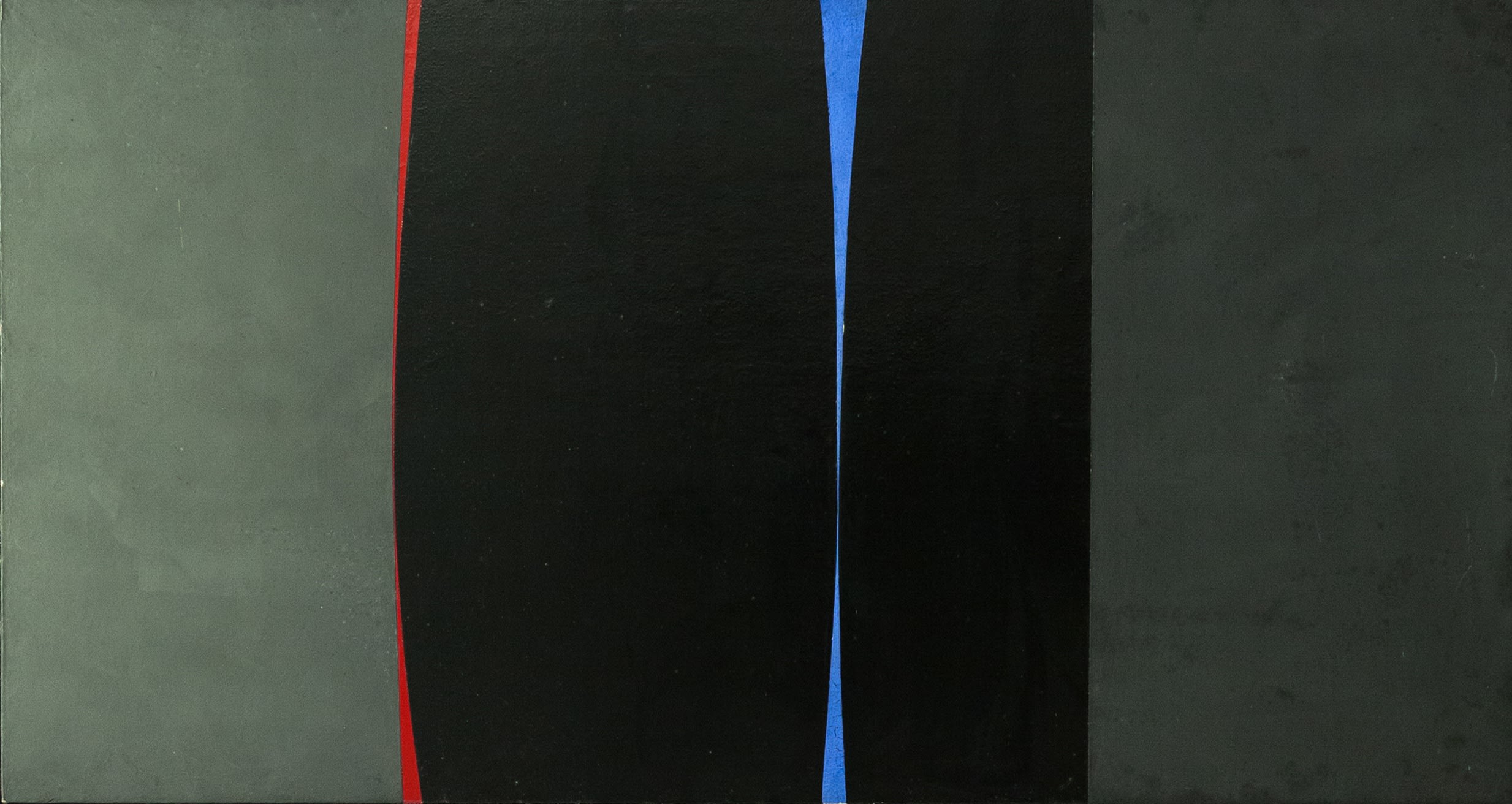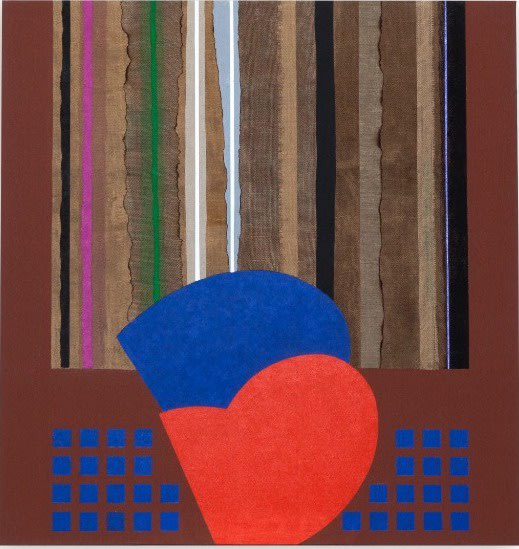Cosmopolitan artist and leader of Moroccan modernity, Mohammed Melehi left us on October 28th at the age of 84.
A pioneer and visionary, Melehi made a major contribution to democratising culture and sharing his art with as many people as possible throughout his life. His career, in Europe and the United States, allowed him to evolve in contact with the avant-gardes and to shape, with his contemporaries, the aesthetics of postcolonial and pan-Arab artistic networks and to lay the foundations of Moroccan artistic modernity.
We would like to pay him a tribute by looking back over his amazing career.
-
THE ROMAN YEARS
Mohamed Melehi began his artistic career at a very young age. First, at the art school in Tetouan, then in Sevilla where he entered the School of Fine Arts at the age of 19 before moving to Madrid the following year. Anxious to get closer to the avant-garde, the artist decided to continue his studies in Italy and moved to Rome in 1957.
Before leaving Morocco, he organized his first solo exhibition at the American Library in Tangier. There, he showed his first abstract paintings and experiments with everyday materials such as jute and the woolen fabrics of the djellabas and haiks. The symbolic resonance of these materials with the local culture interests the painter as much as their aesthetic value. It confirms his emancipation from the academism taught at the Fine Arts School and marks his early desire to establish a new plastic language.
Melehi lived in Rome from 1957 to 1961, where he rubbed shoulders with the most innovative artists, including Lucio Fontana (1899 - 1968), Jannis Kounellis (1936 - 2017), Giuseppe Capogrossi (1900 - 1972), Carla Accardi (1923 - 2014) and Alberto Burri (1915 - 1995). With them, he frequented galleries and discovered the young American abstract expressionist painters Jackson Pollock (1912 - 1956), Willem De Kooning (1904 - 1997), and Robert Rauschenberg (1925 - 2008) whose plastic research would soon influence his work.
His encounter with the gallery owner Topazia Alliata (1913-2015) was decisive. A woman of cosmopolitan culture, she brought together the Italian intelligentsia and the avant-garde artists around her. She will devote four exhibitions to the painter between 1959 and 1963. Black dominates the canvases of this period, and thin vertical bands of color make their appearance. Undoubtedly influenced by his readings on the Zen philosophy, a meditative and silent impression emerges from the canvases of 1961, 1962 within which the vertical, curved, or oblique lines could resemble the vibrating string of an arch. The artist also experimented with his first collages.
-
 Mohamed Melehi, Sans titre, 1962, 76 x 140 cm
Mohamed Melehi, Sans titre, 1962, 76 x 140 cm -
Melehi's work differs from the Italian or even European production of the time and is linked to a new movement that was soon to become one of the major currents of American abstraction in the 1960s: the Hard-Edge, a formula first evoked in 1959 by the critic and curator Jules Langsner (1911-1967) in opposition to abstract expressionism.
"To the destructive and chaotic violence of the Italians and the abstract expressionists, [Melehi] contrasts the rigor and serenity of orderly composition".
Jean-Hubert Martin
-
THE NEW YORK PERIOD AND THE ASSERTION OF A STYLE
Although he was well established on the Roman artistic scene, Mohammed Melehi decided to discover Paris, where he just happened to be passing through without finding any real contacts.
1962 was a decisive year in the artist's life as he decided to leave Europe for the United States, the new epicenter of art. He arrived in Minneapolis in February and became a teacher at the Minneapolis College of Art and Design. The paintings of this period mark a transition in the artist's work. They are reminiscent of the Roman period, with vertical lines running across the canvas from one side to the other combined with geometric shapes. The sun disk becomes recurrent, and soon the vertical lines become horizontal and mix with more angular forms leading to even more radical plastic research, close to the aesthetics of the American artists Ellsworth Kelly (1923 - 2015) or Pierre Rauschenberg (1925 - 2008).
-

Mohamed Melehi, Untitled, 2010, 150 x 150 cm
-
The plastic vocabulary of the artist nurtured during these years. The first paintings of the New York period bear witness to this. They distinguished themself by the appearance of rows of small colored squares arranged in a line on large flat areas of color. Reminiscent of Roman teaching and the pioneers of abstraction such as Piet Mondrian or Sarah Morris, these small squares refer more directly to the perforated card which served as a support for the information used by the computers of the time. The titles of the works from this period testify to his interest in computers and space: IBM (1962), IBM song (1963), Pioneer (1962), which takes the name of a NASA space program, Moon Landing (1963), Space station (1963).
-

Mohamed Melehi, Sans titre, 2018, 90 x 80 cm
-

Mohamed Melehi, Sans titre, 2012, 120 x 115 cm
-
THE CASABLANCA SCHOOL
One condition of winning the Rockefeller Fellowship was the return to Melehi's country of origin to share what he has learned in the United States. On July 5, 1964, Melehi returned to Morocco after ten years abroad. Ten years during which Melehi took part in the emergence of major artistic currents both in Europe and on American soil.
Back home, Melehi is eager to contribute to the cultural dynamism of his country.
He joined the Casablanca School of Fine Arts, which Farid Belkahia, another pioneer of Moroccan modernity, has just taken over. He taught there from 1964 to 1969, alongside two art historians, Toni Maraini (1941) and Bert Flint. They will be joined by his accomplices in Rome, Chabâa (1935 - 2013) and Mohamed Ataallah (1939 - 2014). All of them assimilated the Bauhaus thought, of which Melehi was a fervent defender, and claimed art as a social heritage. Together, they militate for the establishment of new artistic practices inseparable from a broader questioning of society. They are working towards a profound reform of art education, both in its learning methods and in its content.
For them, one of the major challenges of this post-colonial period is to restore a strong relationship with the local cultural heritage and especially with its popular expressions. This will be one of the guidelines of Melehi's teaching.
-
-
The major event of the year 1969, is the exhibition in Jemaâ el-Fna square in Marrakech. Under the title "Présence plastique", five artists - Mohamed Ataalah (1939-2014), Farid Belkahai, Mohamed Chebaa (1936-2013), Mustapha Hafid (1938), Mohamed Hamidi (1941) and Melehi - exhibited their works in the open air. This event is the birth certificate of what art historians now call the Casablanca School and lays the foundations of Moroccan artistic modernity. It is a manifesto attesting to the existence of a pictorial current, at odds with official art. It also asserts the political ambitions that the group defends through abstraction and in line with the Bauhaus claims, it shows an art in dialogue with Moroccan popular arts and more broadly with the arts of Islam.
-
"I hung Berber carpets on the walls. I had them draw and enlarge, in black and white, the lines that structure certain objects, such as fibulas they knew existed (...) I told them about the Bauhaus ...".
Moahmed Melehi
-
During his years of artistic and social activism, Melehi was involved on several fronts and also engaged in ideological struggles which he expressed notably through his participation in the magazine Souffles. Created in 1966 on the initiative of the writer Abdellatif Laâbi, Melehi is its artistic director and graphic designer. A few years later, he founded the art review Intégral, which he ran from 1971 to 1978. In 1973, he created Shoof, a graphic design and publishing agency whose name means "looks" in Arabic.
-
In 1966, he took part in the first edition of the World Festival of Black Arts, organized in Dakar by Léopold Sédar Senghor. He traveled to West Africa with Farid Belkahia. He discovers new geographies and new cultural traditions where the separation between fine and art-crafts wasn't relevant, pushing his reflection even further.
-

-
Under the impulse of research carried out by a group of Iraqi artists and following the publication, in 1962, of Richard Ettinghausen's book entitled La Peinture Arabe, Melehi returned to the aesthetic conception of Muslim civilization. The principle of the latter is to give form to thought by not objectively copying either nature or man. In addition to geometric forms and solid colors, he incorporated a new decorative corpus into his work - a simple disc or one consisting of concentric circles, rainbows, flames, rays, stars, or calligraphy - while favoring the undulating forms that had become characteristic of his pictorial work, which he likened to trees or the curves of the human body, particularly that of women.
The visual impact of these intensely colored motifs was soon reinforced by the choice to abandon canvas in favor of wood panels from 1969/70 onwards, followed by oil and acrylic in favor of cellulosic paint. Melehi thus made one of the central preoccupations of the Russian Constructivists his own: to think of art as a means of production and not as a means of expression. In this perspective, the artist swapped the traditional instruments of the painter for those of the worker and industry. Soon, cellulosic panels on wood were being processed in the painter's duly equipped workshop, surrounded by numerous assistants.
-
Melehi's prolific work has been built up over the years, nourished by his encounters and travels. Dominated by the plastic search for a new form of representation, Melehi's painting imposes a singular aesthetic where figuration and abstraction, identity, and modernity are articulated.
-

-
The exhibition "Melehi, Recent Paintings", organized by the Bronx Museum of the Arts in New York in 1985 (December 6, 1984 - February 10, 1985) laid the foundations for "Melehisme", a hard-edge painting in pop colors which assumes its decorative quality without the slightest complex. It will be followed by many others all over the world. In Paris, the Institut du Monde Arabe devoted a retrospective exhibition soberly entitled "Melehi" (June 27-August 27, 1995) to him, which helped to spread out his ideology. The last few years have seen the acquisition of his paintings by major institutions in Europe, and a major retrospective curated by Morad Montazami has been traveling since last year to three continents. "New Waves, Mohamed Melehi and the Archives of the School of Casablanca" retraces the artist's journey within the Moroccan art scene of the sixties. After a stopover at the Mosaic Room in London (Dates) and the Al Maaden Museum of Contemporary African Art in Marrakech - Macaal, it is still visible in Dubai, at the Alserkal Foundation until the end of the month.
Sculptor, painter, teacher, Melehi was an accomplished artist committed to a universalist vision in accordance with the times.
Today we salute the career of this great man and our affection goes out to his wife Khadija, his children, his entire family and his many friends.













